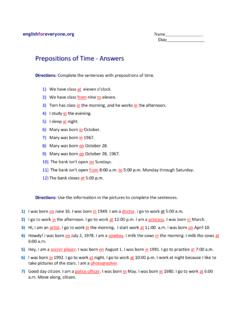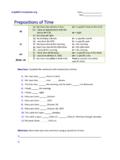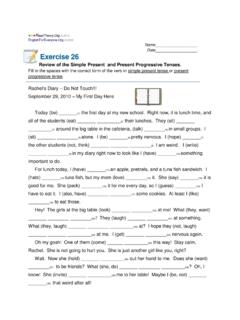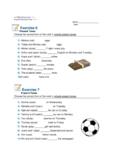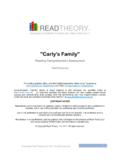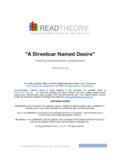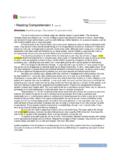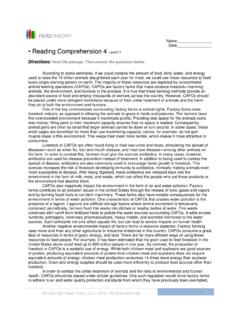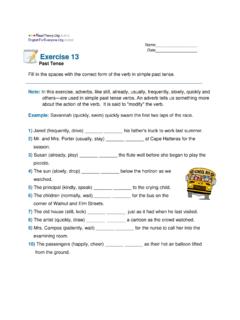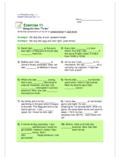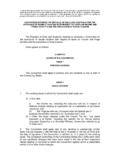Transcription of eRReaaddiinngg sCCoommpprreehheennsiioonn 55 Level 11
1 Copyright Read Theory LLC, 2012. All rights reserved. 1 READTHEORY Name_____ Date_____ rreeaaddiinngg CCoommpprreehheennssiioonn 55 Level 11 DDiirreeccttiioonnss:: Read the passage. Then answer the questions below. English Ivy betrays its poor reputation as a nuisance by its unparalleled ability to provide shade. By seamlessly covering the exterior of a building, it works as a natural insulator, blocking the sun and decreasing air conditioning costs. This means big savings for both building tenants and homeowners alike. And it can happen quickly, too. Under the proper conditions, established English Ivy can grow to cover an area of roughly 500 square feet per year.
2 Given that most homes have a roof measuring roughly 2000 square feet, ivy-friendly homeowners can rest assured that their roofs will be completely covered in about four years. When considering growth rates of newly planted ivy, just remember the old adage: First year, it sleeps. Second year, it creeps. Third year, it leaps! For English Ivy, this is especially true. Now, detractors may take this opportunity to remind readers about how invasive English Ivy can be. For what ivy enthusiast hasn't been cautioned about its ability to burrow holes, fracture windows, and even deteriorate brick? But be warned. Oftentimes, this suggestion is taken to the comical extreme. Naysayers take a strange pleasure in spinning yarns about a particularly malevolent strand of ivy one that slips in through the cracks on a hot summer night, silently strangling homeowners in their sleep.
3 Admittedly, this can be a funny story to tell. But are we to believe such a tale? The intelligent gardener will quickly dismiss such rubbish for what it is. Questions 1) The primary purpose of the passage is to A. highlight the reasons why English Ivy s fast growth rate is beneficial B. argue that English Ivy is an essential plant for homeowners C. educate readers about how to use English Ivy to insulate their homes D. belittle detractors of English Ivy E. defend the reputation of English Ivy 2) As used in paragraph 1, which is the best definition for betrays? A. gives away B. contradicts C. reveals D. supports E. highlights 3) In paragraph 1, the author states, Given that most homes have a roof measuring roughly 2000 square feet, ivy-friendly homeowners can rest assured that their roofs will be completely covered in about four years.
4 Which of the following logical mistakes does the author make in drawing this conclusion? I. English Ivy will not cover the area of most roofs in 4 years if it only grows 500 square feet per year. II. Most homes may not have the proper conditions necessary for English Ivy to grow at the specified rate. III. Newly planted ivy does not grow as fast as established ivy. Copyright Read Theory LLC, 2012. All rights reserved. 2 A. I only B. II only C. I and II only D. II and III only E. I, II, and III 4) As used in paragraph 2, which is the best definition for deteriorate? A. wear away B. shield C. add to D. climb on E. strengthen 5) Based on information in paragraph 1, which of the following would most likely be considered an insulator?
5 A. an umbrella B. an automobile C. suntan lotion D. skin E. a winter jacket 6) As used in paragraph 2, which is the best antonym for malevolent? A. wary B. sensitive C. virtuous D. injured E. willing 7) This passage would most likely be found A. in a scholarly journal about botany B. in a magazine article about gardening C. in a letter from one gardener to another D. on a website identifying different types of plants E. in a pamphlet about the best ways to make a home more energy-efficient 8) The author's tone can best be described as A. passionate B. indignant C. argumentative D. persuasive E. accusatory Copyright Read Theory LLC, 2012. All rights reserved.
6 3 Answers and Explanations 1) E To answer this question correctly, we must study the first sentence: English Ivy betrays its poor reputation as a nuisance by its unparalleled ability to provide shade. In this sentence, the author lets us know that he or she is providing reasons why English Ivy betrays, or contradicts, its poor reputation. In other words, the author intends to point out some benefits of English Ivy. By pointing out these benefits, as well as discrediting detractors of ivy who often take a strange pleasure in spinning yarns about it, the author defends the reputation of English Ivy. Therefore (E) is correct. Although the author does highlight one reason why English Ivy s fast growth rate is beneficial (it will quickly cover a house and thus act as a natural insulator), he or she does not point out more than one reason.
7 Furthermore, this minor point serves the author s larger argument, which is that English Ivy does not deserve its poor reputation. Therefore (A) is incorrect. The author does not argue that English Ivy is an essential plant for homeowners, only that it does not deserve its reputation as a nuisance. This means (B) is incorrect. In paragraph 1, the author states that homeowners can use ivy to insulate their homes, but he or she does not provide details about precisely how to do this. The author s lack of specific directions indicates that he or she is more concerned with defending English Ivy s reputation than with educating readers. This makes (C) incorrect. The author does not intend to belittle, or disparage, detractors of English Ivy, but rather to contradict them.
8 Although the author does gently mock their tendency to take a strange pleasure in spinning yarns about ivy, this statement is not so harsh as to be considered belittling. Therefore (D) is incorrect. 2) B betray (verb): to be unfaithful in guarding, maintaining, or fulfilling. In paragraph 1, the author indicates his or her intention to explain how English Ivy betrays its poor reputation as a nuisance. The author then goes on to cite reasons why English Ivy is beneficial. Based on this information, we can infer that English Ivy has a bad reputation, but in the author s opinion, it does not deserve such a reputation. This means that in this context betrays means goes against or fails to remain true to.
9 Contradicts is the only answer choice that reflects this meaning, so it is a good definition in this context. Therefore (B) is correct. Although the word betray is often used to describe the act of treason, or someone who disloyally gives away secrets, this is not the definition used in the passage. This means (A) is incorrect. While betray can mean to reveal information that should remain secret, this is not the definition used in the passage. Indeed, in this context, if the English Ivy revealed its poor reputation as a nuisance, it would confirm it, not contradict it. This makes (C) incorrect. Support means to maintain. This is the opposite meaning of contradict, so (D) is incorrect.
10 Highlight means to emphasize. This is the opposite meaning of contradict, so (E) is incorrect. 3) D In paragraph 1, the author states, Under the proper conditions, established English Ivy can grow to cover an area of roughly 500 square feet per year. Given that most homes have a roof measuring roughly 2000 square feet, ivy-friendly homeowners can rest assured that their roofs will be completely covered in about four years. 500 (square feet) multiplied by 4 (years) equals 2000 (square feet). Given that English Ivy can grow to cover an area of roughly 500 square feet per year, and most homes have a roof measuring roughly 2000 square feet, then it makes mathematical sense to figure that English Ivy will indeed have enough time to cover the area of most roofs in 4 years.
